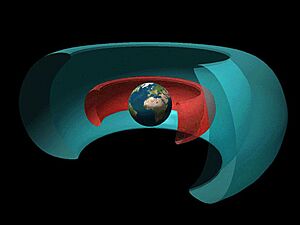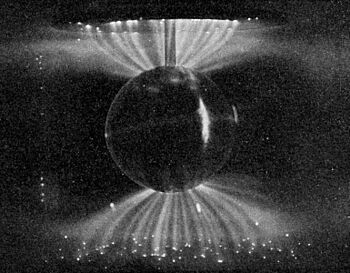Van Allen radiation belt facts for kids
The Van Allen radiation belts are areas of energetic particles around Earth. These particles come mostly from the solar wind. Earth's magnetosphere (its magnetic field) traps them. Earth usually has two main belts. Sometimes, a third one can appear for a short time. They are named after scientist James Van Allen. He wrote about them in 1958.
These belts stretch from about 640 kilometers (400 miles) to 58,000 kilometers (36,000 miles) above Earth. The amount of radiation changes in these areas. They are found in the inner part of Earth's magnetic field. They trap fast-moving electrons and protons. By trapping the solar wind, Earth's magnetic field protects our atmosphere.
The belts can be dangerous for satellites. Satellites need special shielding to protect their parts if they stay in this zone for long. Astronauts on the Apollo missions traveled through the Van Allen belts. They received a very small and safe amount of radiation.
In 2013, the Van Allen Probes found a temporary third radiation belt. It lasted for about four weeks.
Contents
How Were They Found?
Scientists like Kristian Birkeland and Carl Størmer thought about trapped charged particles as early as 1895. This helped set up the idea for radiation belts.
The Soviet satellite Sputnik 2 and later the US satellites Explorer 1 and Explorer 3 confirmed the belts in 1958. They were later named after James Van Allen from the University of Iowa. Other missions like Explorer 4 and Pioneer 3 helped map these trapped radiation areas.
The name Van Allen belts is only for the belts around Earth. But similar radiation belts have been found around other planets. The Sun does not have long-lasting radiation belts. This is because it does not have a stable magnetic field like Earth.
Earth's atmosphere stops the belt particles below 200–1,000 kilometers (124–620 miles). The belts do not go past 8 Earth radii from Earth. They are mostly found within 65 degrees of the celestial equator.
Studying the Belts
The NASA Van Allen Probes mission aimed to understand how these particles form and change. They wanted to see how the belts react to changes in solar activity and the solar wind.
The Van Allen Probes launched on August 30, 2012. They were planned to work for two years but lasted four. The probes were turned off in 2019 because they ran out of fuel. They are expected to fall back to Earth in the 2030s.
Radiation belts exist around other planets and moons that have strong magnetic fields. Most of these belts have not been fully mapped yet. The Voyager Program confirmed similar belts around Uranus and Neptune.
Geomagnetic storms can make the number of electrons in the belts change quickly. This can happen in about a day or less. Longer processes set the overall shape of the belts. After a storm, the number of electrons often goes down slowly.
Inner Belt
The inner Van Allen Belt usually goes from about 1,000 kilometers (620 miles) to 12,000 kilometers (7,500 miles) above Earth. In some cases, like during strong solar activity, it can get as low as 200 kilometers (124 miles) above Earth. This happens in areas like the South Atlantic Anomaly.
The inner belt has many electrons with hundreds of keV of energy. It also has energetic protons with over 100 MeV of energy. These particles are trapped by the strong magnetic fields in this area.
Scientists think that protons with over 50 MeV of energy come from beta decay of neutrons. These neutrons are made when cosmic rays hit the upper atmosphere. Lower energy protons are thought to spread from changes in the magnetic field during geomagnetic storms.
Because the belts are slightly off-center from Earth's middle, the inner Van Allen belt gets closest to the surface at the South Atlantic Anomaly.
In 2014, a pattern like "zebra stripes" was seen in the inner belt by the Van Allen Probes. A 2016 study said these stripes were caused by ionospheric winds affecting the radiation belts.
Outer Belt
The outer belt mainly has high-energy electrons (0.1–10 MeV). These are trapped by Earth's magnetosphere. It changes more than the inner belt because it is more affected by solar activity. It is shaped like a donut. It starts at about 13,000 kilometers (8,000 miles) and goes out to 60,000 kilometers (37,000 miles) above Earth. Its strongest part is usually around 4 to 5 Earth radii.
The outer electron belt is mostly made by particles moving inward and speeding up. This happens when energy from plasma waves transfers to the electrons. Electrons are also lost from the belt when they hit Earth's atmosphere or move outward.
In 2014, scientists found that the inner edge of the outer belt is very sharp. Very fast electrons (over 5 MeV) cannot get past this edge. Scientists do not fully understand why this "shield" effect happens.
The outer belt has many different particles, including electrons and various ions. Most ions are energetic protons. But some are alpha particles and O+ oxygen ions. This mix suggests that these particles come from more than one source.
The outer belt is larger than the inner belt. Its particle numbers change a lot. The number of energetic particles can go up and down greatly during geomagnetic storms. These storms are caused by magnetic field changes from the Sun. The increases happen when particles from the magnetosphere's tail are injected and sped up.
On February 28, 2013, a third radiation belt was reported. It had very high-energy charged particles. NASA's Van Allen Probe team said this third belt was made by a coronal mass ejection from the Sun. It appeared to split the outer belt and lasted for about a month before joining back with the outer belt.
This third, temporary belt was unusually stable. This is because Earth's magnetic field "trapped" these very fast particles. They were too energetic to scatter into the atmosphere. This trapping allowed them to last a long time. They were only destroyed by a strong event, like a shock wave from the Sun.
Space Travel and the Belts
Spacecraft traveling beyond low Earth orbit enter the Van Allen belts. Beyond the belts, they face other dangers from cosmic rays and solar particle events. There is a region between the inner and outer Van Allen belts. It is sometimes called the "safe zone" and is about 2 to 4 Earth radii from Earth.
Solar cells, integrated circuits, and sensors can be harmed by radiation. Strong magnetic storms can sometimes damage electronic parts on spacecraft. Modern electronics are smaller and more digital. This makes satellites more sensitive to radiation. The Hubble Space Telescope often turns off its sensors when it passes through areas with strong radiation.
A satellite with 3 millimeters (0.12 inches) of aluminium shielding in an elliptic orbit (200 by 20,000 miles or 320 by 32,000 kilometers) will get about 25 Sv of radiation per year. For comparison, a full-body dose of 5 Sv is deadly. Almost all of this radiation would be received when passing through the inner belt.
The Apollo missions were the first time humans traveled through the Van Allen belts. Mission planners knew about this radiation danger. The astronauts had low exposure in the belts because they spent only a short time flying through them.
The total radiation astronauts received varied by mission. It was between 1.6 and 11.4 mGy. This was much less than the yearly safety limit for people working with radioactivity.
What Causes the Belts?
The inner and outer Van Allen belts are formed by different processes. The inner belt has energetic protons. These protons come from the decay of "albedo" neutrons. These neutrons are made when cosmic rays hit the upper atmosphere. The outer Van Allen belt mainly has electrons. These electrons are injected from the geomagnetic tail after magnetic storms. Then they get more energy from wave-particle interactions.
In the inner belt, particles from the Sun are trapped in Earth's magnetic field. Particles spiral along the magnetic lines. As they move toward the poles, the magnetic field gets stronger. This slows them down and sends them back toward the equator. So, they bounce back and forth between Earth's poles. Electrons also slowly drift eastward, while protons drift westward.
The space between the inner and outer Van Allen belts is called the "safe zone." This is where medium Earth orbits are located. This gap is caused by VLF radio waves. These waves scatter particles, sending new ions into the atmosphere. Solar outbursts can also put particles into the gap, but they drain out in a few days.
Scientists used to think these VLF radio waves came from turbulence in the belts. But recent work by J.L. Green suggests they are made by lightning in Earth's atmosphere. These radio waves hit the ionosphere at the right angle to pass through only at high latitudes. This is where the lower parts of the gap get close to the upper atmosphere. Scientists are still discussing these findings.
Antimatter in the Belts
In 2011, a study confirmed that the Van Allen belts could hold antiparticles. The PAMELA experiment found many more antiprotons than expected while passing through the South Atlantic Anomaly. This means the Van Allen belts trap a lot of antiprotons. These antiprotons are made when cosmic rays interact with Earth's upper atmosphere. The energy of these antiprotons is between 60 and 750 MeV.
Research has suggested that collecting these antiprotons for spacecraft propulsion could be possible. Scientists believe this would be better than making antiprotons on Earth. This is because collecting them in space avoids transport costs and losses. Jupiter and Saturn might also have antiprotons, but Earth's belt is the most productive.
Ideas for Removing the Belts
Draining the charged particles from the Van Allen belts would create new orbits for satellites. It would also make space travel safer for astronauts.
One idea is called High Voltage Orbiting Long Tether, or HiVOLT. This concept was proposed by Russian physicist V. V. Danilov. It was later improved by Robert P. Hoyt and Robert L. Forward. It aims to drain and remove the radiation fields of the Van Allen belts.
Another idea for draining the belts involves sending very-low-frequency (VLF) radio waves from the ground into the belts.
Draining radiation belts around other planets has also been suggested. For example, this could be done before exploring Europa, which orbits within Jupiter's radiation belt.
As of 2024, scientists are not sure if removing these radiation belts would have any negative side effects.
See also
 In Spanish: Cinturones de Van Allen para niños
In Spanish: Cinturones de Van Allen para niños
- Dipole model of the Earth's magnetic field
- L-shell
- List of artificial radiation belts
- Space weather
- Paramagnetism





